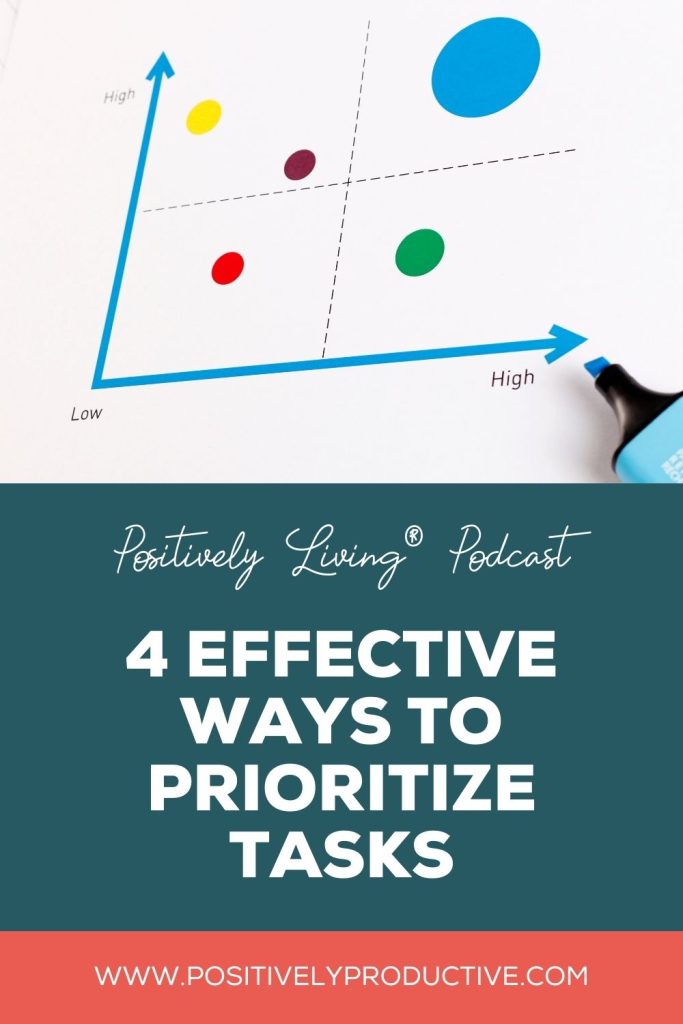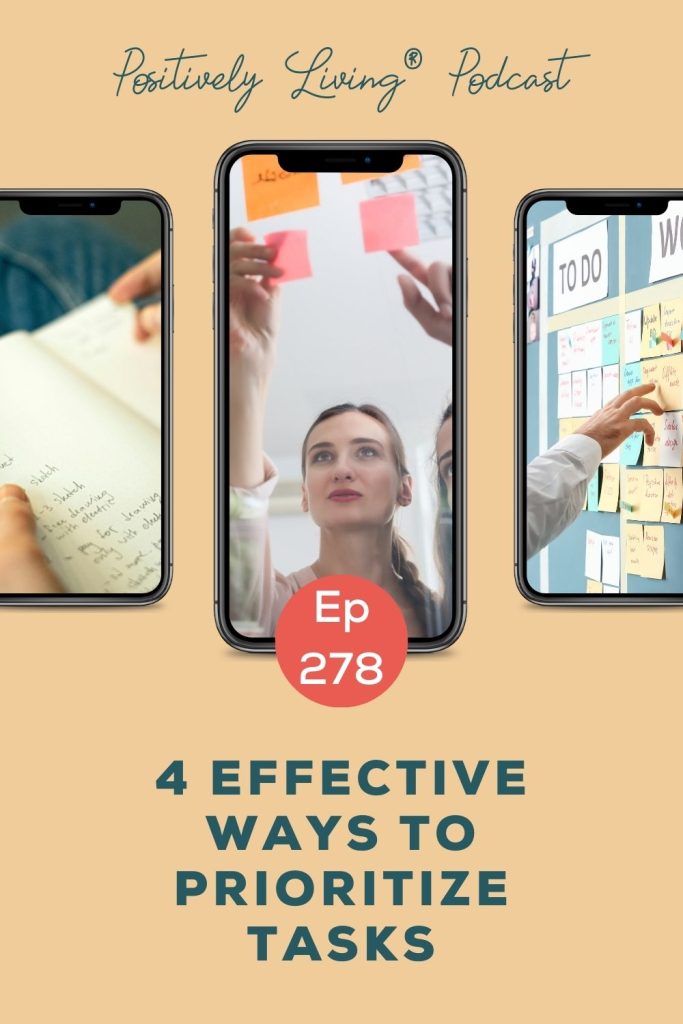Prioritizing tasks is a common challenge for so many of us, especially those of us who are neurodiverse and often struggle with competing demands, fluctuating energy, and the constant pull of urgency. Maybe you’re staring at a mountain of tasks where everything feels important and you have no idea where to begin. But what if, by exploring your unique tendencies, you can quiet the noise, sort through the chaos, and tackle what truly matters?
In this episode of the Positively LivingⓇ Podcast, I explore four popular methods to prioritize tasks effectively, breaking down the pros and cons of each to help you figure out which method fits you best.
Why Prioritization Matters
Let’s quickly review why prioritizing is a must. To state it most simply, if everything is a priority, nothing is a priority. And when you don’t have a clear starting point, you will have major delays and challenges reaching your end goals.
When everything feels urgent, we fall into reactivity. Instead of intentionally choosing what matters most, we end up jumping from one demand to the next, often finishing our day exhausted but unsure if we accomplished anything meaningful. Our day may be finished, but our important tasks, not so much.
Research in cognitive psychology shows that our brains are wired to respond to urgency because it activates the stress response, increasing cortisol and narrowing our focus. That’s a big part of why neurodiverse minds crave it. And it really is helpful for special deadlines and in true emergencies. But when you do this chronically, it overwhelms the nervous system and reduces your ability to function, focus, and make good decisions.
Prioritization is a selection tool that helps you do what matters most. The right method can help you conserve mental energy, create clarity, and build momentum toward your goals.
I’m going to do my best to help you choose, and have selected 4 methods that are most well-known and used for us to review. The four systems include The Eisenhower Matrix, Eat the Frog, MITs, and The ABC Method. Some of these you may have heard of, and some may sound foreign, though I bet when we dig in, you’ll find them familiar.
The Four Systems
1. The Eisenhower Matrix
Inspired by Dwight D. Eisenhower’s approach to time management, this framework separates tasks into four quadrants:
- Urgent and Important: Do these tasks immediately.
- Important, but Not Urgent: Schedule these tasks for later.
- Urgent, but Not Important: Delegate these tasks if possible.
- Neither Urgent nor Important: Eliminate these tasks.
Pros: This tool offers a powerful visual that helps you separate true importance from perceived urgency. It’s especially effective for big-picture thinkers who need clarity on what to delegate or eliminate.
Cons: Classifying every task can be time-consuming, and for those who struggle with categorization, it can add more stress than clarity. Plus, it can be hard to resist the pull of tasks that feel urgent, even if they aren’t important.
Best fit: Questioners who enjoy sorting and analyzing, and Upholders who appreciate structure, will likely find this method most effective. Obligers may struggle with the urge to prioritize other people’s needs over their own important, but not urgent, tasks.
Pro-Tip: When a task feels urgent, ask yourself, “Whose urgency is this?” This simple question can help you regain control and decide whether the task truly needs your immediate attention.
2. Eat the Frog
This method, a nod to a quote often attributed to Mark Twain, is all about tackling your most challenging or dreaded task—your “frog”—first thing in the morning.
Pros: Getting the toughest task out of the way first can reduce mental energy wasted on dread and create powerful momentum. Our willpower decreases throughout the day, so taking on a hard task early can be highly effective.
Cons: If your mornings aren’t your peak energy time, this method can feel punishing. It can also be intimidating if your “frog” feels too big, potentially leading to more procrastination.
Best fit: Rebels may enjoy the thrill of slaying the dragon early, and Upholders will appreciate the sense of accomplishment. Obligers may need an accountability partner to make sure they stick with it.
Pro-Tip: Your “frog” doesn’t have to be a tough task—it just has to feel tough to you. If phone calls make you anxious, making one first thing in the morning can be your frog. It’s about getting the heaviest mental lift off your shoulders.
3. MITs (Most Important Tasks)
This simple method asks you to identify just one to three key tasks each day that you absolutely must complete.
Pros: It’s simple, adaptable, and prevents endless to-do lists from taking over. By narrowing your focus, it also reduces the decision fatigue that often leads to procrastination.
Cons: It takes discipline to stop at three tasks. It can also be easy to label too many things as “important,” especially if you’re an Obliger who feels pressure to please others.
Best fit: Obligers benefit from the clear boundaries and focus this method provides, while Questioners will appreciate the logical reasoning behind narrowing their priorities.
4. The ABC Method
With this system, you label your tasks in a clear hierarchy:
- A: Must do
- B: Should do
- C: Nice to do
You can even number them (A1, A2) for a more granular approach.
Pros: This method creates a clear hierarchy and works well for people who enjoy ranking and categorizing. It’s great for highly structured environments.
Cons: It can feel rigid and requires constant re-ranking as priorities shift. For some, this rigidity can lead to perfectionism or analysis paralysis.
Best fit: Upholders will love the order and clarity. Questioners will be drawn to the logical reasoning behind the ranking.
Bonus Method: Energy-Based Prioritization
This less-structured method encourages you to choose tasks based on your current energy level and natural productivity rhythm. For example, you might tackle your most demanding tasks when your energy is high and save easier tasks for when you feel a dip. This approach is highly focused on self-awareness.
Best fit: Rebels often thrive with this approach, as it offers maximum flexibility. It can also be very helpful for Obligers if they are willing to prioritize their own feelings and energy levels in the moment.
How to Choose and Take Action
Ready to get started? Here are a few steps to help you find the right fit:
- Experiment with one method at a time. Choose a system and stick with it for at least a week to give it a fair try.
- Consider your tendencies. Start with a method that aligns with your personality. If you’re not sure of your tendencies, you can find a quiz in the free Positively Productive Toolkit (link below).
- Check how it feels. After a week, ask yourself: Did this bring me clarity and calm, or did it add more stress? Your answer will tell you everything you need to know.
- Mix and match. You don’t have to stick to one system forever. The Eisenhower Matrix might work for your weekly planning, while the MITs method is perfect for your daily to-do list.
Ultimately, the best prioritization system is the one that works for you, in your life, right now. It’s about shifting from a reactive mindset to an intentional one so you can choose what truly matters most.
Looking for hands-on tools? Grab my free Positively Productive Toolkit at positivelyproductive.com/plpkit. Inside, you’ll find an assessment workbook that includes a link to the Four Tendencies quiz, along with other self-discovery tools to help you customize your productivity.











